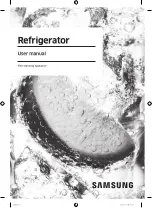
Instructions for Use
16
With smaller refrigerators we recommend you make a stock of
ice cubes (store them in a separate plastic box).
The easiest way to empty the ice tray is to turn the tray around,
pour it with cold water and slightly twist it (bend it).
Maintenance and Cleaning
Automatic Defrosting of the Refrigerator
The refrigerator requires no defrosting, since the ice at the rear
wall melts automatically. Ice, formed at the rear end during the
operation of the compressor, melts when the compressor is off,
and water drops slide downwards through the hole in the rear
wall o the condenser collecting receptacle, placed at the
bottom of the appliance.
Manual Defrosting of the Frezing Compartment
When the frost and ice layer in the frezing compartment is 3-5
mm thick, you should clean the freezer.
•
Turn the thermostat knob to
STOP (0)
position, and
disconnect the power supply. Empty the compartment and
take care that the packages remain frozen.
•
Melted water, collected at the bottom of the appliance,
should be mopped with an absorbing cloth.
•
Avoid using defrosting sprays, as they may cause damage
to the plastic parts and may be hazardous to health.
Cleaning the Appliance
Disconnect the power supply before cleaning the
appliance.
Do not use coarse or aggressive cleaning agents as you can
damage the surface. Be careful to remove any cleanser agent
remaining after cleaning.
•
Clean the
exterior
with water and detergent.
Varnished surfaces are cleaned with soft cloth and an
alcohol based cleaning agent (for example glass cleaners).
You may also use alcohol (ethanol or isoprophylic alcohol).
The application of abrasive and specially aggressive
cleaners, such as the stainless steel cleaners, is not
appropriate for the cleaning of plastic and coated parts.
•
Remove the
detachable accesories
in the interior of the
appliance and clean it with water and liquid detergent.
Plastic parts cannot be washed in washing machine.
•
Wash the
interior
of the appliance with lukewarm water, in
which you added one or two spoonfuls of vinegar.
•
The air openings in the bottom rail
should be cleaned or
vacuumed periodically.
Cleaning of the condenser
Dust from the condenser should be vacuumed in the
following manner:
−
push the finger through the opening in the bottom rail
and release the fastener;
−
pull the rail towards you and remove it;
−
remove the bottom board of the kitchen cabinet
−
pull the condenser dish out;
−
use the vacuum cleaner to clean the dust from the
condenser;
−
replace the condenser dish and the bottom rail in the
opposite order.
After cleaning, connect the appliance to power supply and
reload the packages.
Periodical cleaning of the condenser
In order to optimize the operation of the appliance and
save energy, it is recommended to clean periodically the
dust from the condenser at the back of the appliance.
Disconnect the appliance from the mains prior the
commencement of cleaning!
•
Empty the contents of the appliance.
•
Remove the supporting panel from the bottom of the kitchen
cabinet.
•
Remove the screws fixing the appliance to the kitchen
worktop.
•
Pull the appliance out and expose the condenser at the back
of the appliance.
•
Unscrew the screws from the condenser bonnet and remove
the bonnet.
•
Clean the dust and dirt from the condenser.
After cleaning return the appliance to its place, plug in the
mains power cord and fill with food.





































